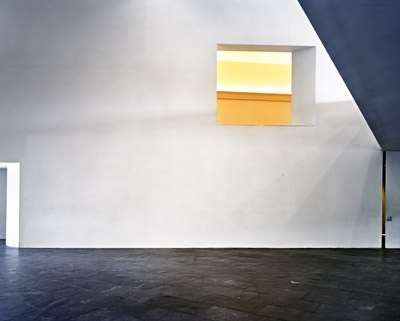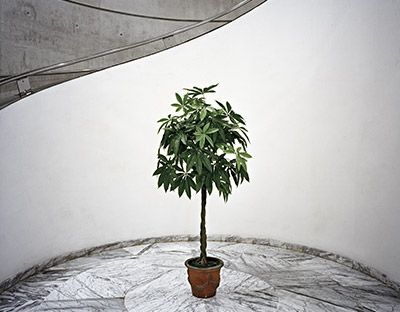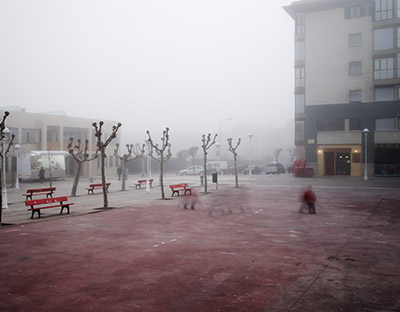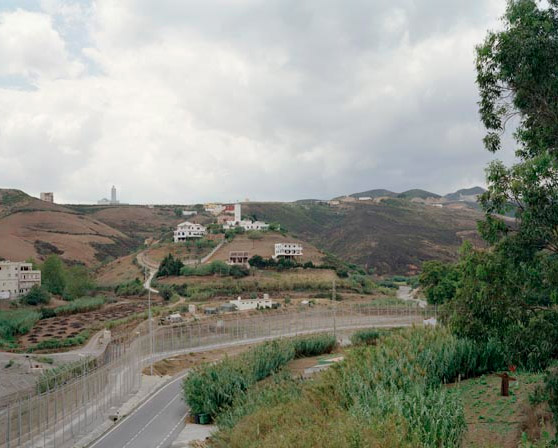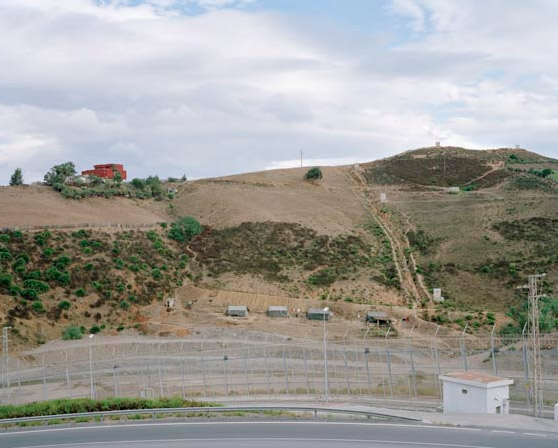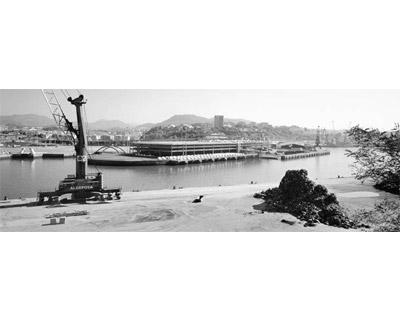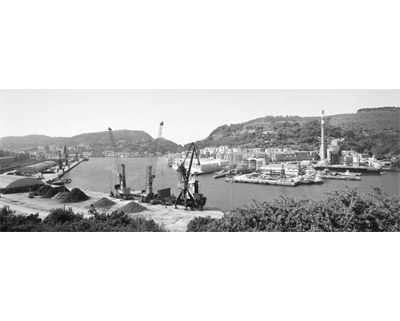Tender Puentes is a curatorial project promoted by Museo Universidad de Navarra since 2002. The Museum's Collection traces the history of photography in Spain, from its origins (the first dates from 1848) to the present day, focusing on photography from its documentary aspect to its relationship and influence with the real and the imaginary. Tender Puentes As a project, it proposes a dialogue between contemporary photographers or artists and the Museum's Collection.
The program is a reflection of MUN's artistic project: a museum that researches with artists and accompanies them in their creative process, the experience serves as a methodological basis to launch, in 2016, a program of Artistic Creation Residencies in the field of performing arts and music.
Fernando Pagola knows the project well as he has been involved in the Museum since its origins. This closeness and deep knowledge is reflected in a masterful way in the creative project and its careful staging.
The three "movements" of this Triple Concert gave rise to various conferences and workshops, as well as a dance intervention by the choreographer and dancer Jon Maya, who offered the creation Tres Movimientos (Three Movements) after talking with Pagola and addressing the common themes and interests from their different languages. A work that shows the transdisciplinary character and will of the Museum's projects.
To learn more
Access to the exhibition website
Create your user on the Museum's exclusive content platform to access the artist's Masterclass prior to the opening.
Available at the Museum's reception desk the catalog and the exhibition's collectible and room sheet.
The Waiting Game III closes the artist's trilogy about "waiting", in this case it is the waiting of the dog that guards a property. The previous volumes were dedicated to road prostitution in the Spanish Levant and fishing in ditches or marshes. A project awarded by the publishing house RV that closes with this "Waiting Game III" that is published by the same publishing house with the support of Museo Universidad de Navarra.
Large-format photographs confront the visitor with the breadth of the artist's gaze, the light of the Mediterranean and a refined photographic technique that is the artist's trademark.
To learn more
Access to the exhibition website
Access the virtual tour of the exhibition
Create your user on the Museum's exclusive content platform to access the Masterclass with the artist prior to the opening of the exhibition.
Available at the Museum's reception desk the exhibition catalog as well as the collectible and room sheet of the exhibition.
José Luis Alexanco tackles this creative project in collaboration with the Museum's artistic directors, Valentín Vallhonrat and Rafael Levenfeld, and plans to create his "Fourth Tenth". The death of the artist while he was working on this "Fourth Tenth" left the piece partly unfinished and only 9 pieces make up this last Tenth of the artist. Hence the name of the exhibition and the project.
The exhibition, at the express wish of the artist, is planned for the year 2022, the date of the 50th anniversary of the "Encuentros de Pamplona del 72" that he helped to organize as part of the Alea Collective and thanks to funding from the Huarte Family.
During the exhibition period, several conferences on the work and figure of José Luis Alexanco were held, as well as workshops for children and families. The inauguration coincided with the program organized by the Government of Navarra around the "Encuentros de Pamplona 72-22".
To learn more
Access to the exhibition website
Access to the virtual tour of the exhibition
Create your user on the Museum's exclusive content platform to access:
- The masterclass prior to the opening of the exhibition by Sergi Aguilar
- Alfonso de la Torre's lecture on Percursum.
- Capi Corrales' lecture "Cómo hacer cosas con... mathematics".
Available at the Museum's reception desk the collectible and the exhibition room sheet.
The creative project The Edge is the result of Álvaro Laiz's work developed between 2016 and 2022. The artist retraced the steps of the first settlers of America who arrived in migrations thousands of years ago from the Bering Strait.
Time, space, the genetics of populations and the culture of peoples come together in an ambitious project that immerses the visitor in an exciting visual journey in which the artist's major concerns come together.
Subjugated by the ancient techniques of developing photography and by the portraits of the pioneers of this art, Laiz weaves through his works and the route established in the Museum, an ambitious journey that ends in this exhibition in Tierra de Fuego but that will continue to the southern tip of the continent.
The project was supported by National Geographic Fellows and the Burroughs Foundation and was accompanied by an action that sought to measure its sustainability both as an art project and as an exhibition project. Beyond The Edge. The Museum accompanied this initiative of the artist through a collaboration with the School of Architecture, measuring the actual consumption and energy performance of its facilities in order to design a plan to optimize its environmental impact as part of the University's Strategy 2025. This work was exhibited at the ICOM 2022 Congress held in Prague.
A Masterclass by the artist, an activity linked to the New European Bauhaus Festival and several children's activities were programmed around the exhibition.
To learn more:
Create your user and access the Museum's exclusive content platform to view:
- Alvaro Laiz's Masterclass prior to the opening of the exhibition.
- The conference "How to do things with our ancestors".
Exhibition Site
Virtual Visit
Buy the photobook of the exhibition
Available at the Museum's reception desk the collectible and the exhibition room sheet.
In co-production with the Centre Galego de Arte Contemporánea, this exhibition brings us closer to Hamish Fulton's creative project. The line of work of this artist-walker joined the inverse route of the Camino de Santiago: from Hendaye to Santiago.
The exhibition showed the evolution of the artist as well as his current concerns about sustainability, the use of technology and the need for direct experience of nature.
During the presentation of the exhibition the artist approached the keys of his work in a masterclass whose text can be read in this link, and shared two artistic actions with students of the Campus in the esplanade of the Faculty of Communication(Walking in every direction) and with the citizens of Pamplona in a central square of the city(Slowalk).
Various workshops for children and schoolchildren were held in connection with the project.
To learn more:
Create your user and access the Museum's exclusive content platform where you will find the Masterclass with artist Hamish Fulton prior to the opening.
Access to the exhibition website
Access to the virtual tour
Buy the exhibition catalog
Available at the Museum's reception desk the collectible and the exhibition room sheet.
The physical and chemical processes and the forms they adopt are the phenomena that are the backbone of this creative project by Carlos Irijalba. The artist explores on the one hand the limits of the collection in its physical and chemical aspects, in addition to the image that is not built optically, but under various other processes, from medical laboratories to scanning electron microscopes. Waynside is, in the artist's own words, "about the cross-cutting relationships between parallel dynamics. The sumptuous forms of lava lava behave in the same way as the meander of a river or the design of the circulatory system that irrigates our brain as we read this text or identify that image. A material passing through a liquid state before solidifying and subsequently conducting a gas, versus the sediments of a delta rearranging itself."
Aesthetics is a key thread, as it is one of nature's oldest and most effective strategies.
This research, which has counted on the collaboration of professionals from various scientific disciplines, practices an approach to crystallization that gives body to something that initially has none, from what is pure matter or abstraction to the immaterial flows that generate reality or give rise to our own experience. Matter adopts diverse forms in different physical or temporal scales and needs both dimensions to happen and transcend thanks to the relationship of one with the other.
To learn more
The Aleatoris Vulgaris series was exhibited at the Museum as part of the Pseudologia Fantastica exhibition. The series, inspired by the Museum's collection, challenges the very logic of the archive. While an archive is constructed with the intention of ordering and grouping elements that already exist, giving them an order to facilitate their location, the project plays with the creation of random algorithms using the most disparate means of selecting and recording the various pieces catalogued in the Museum's collection.
Cristina De Middel's work investigates the ambiguous relationship between photography and truth. Combining documentary and conceptual approaches, she plays with the reconstruction of archetypes and stereotypes that help to blur the separation between reality and fiction and suggests that we apply a critical eye to the way in which reality is told to us. On this occasion, he invites us to explore the impossibility of randomness.
To learn more:
Access to the exhibition website
Access the virtual tour of the Pseudologia Fantastica exhibition, which includes this project.
Available at the Museum's reception desk the collectible and the exhibition room sheet.
The London-based Japanese artist created a creative project about memory and forgetting, the relationship we have with both concepts and how it affects our lives.
His exhibition, which incorporated moving image pieces and installations, included a Masterclass with the artist, various actions with the Faculty of Medicine and the University's School of Nursing, as well as a Japanese film series on everyday life and the construction of family memory.
As part of the Museum's film series, a screening of Spanish classics was included, including El perro andaluz , which the artist includes as reference works for him. The screening included the participation of a Japanese jazz duo and the artist himself, who performed live music.
The artist's project Tender Puentes was collected in a special volume of the collection called Figment.
To learn more:
Project website
Masterclass with the artist
The artist talks about the exhibition and the project.
Dialogues with the work of Hiraki Sawa
Silent film classics with Hiraki Sawa
Virtual tour of the exhibition
Available at the Museum's reception desk the collectible and the exhibition room sheet.
The artist explains the exhibition that gathers the creative project and its arrangement in the Museum's rooms:
Photographer Aitor Ortiz has chosen for his creative project the works from the Museum Collection that belong to the period of the industrial revolution at the Altos Hornos de Bilbao and those from José Martínez Sánchez's bridge album. Both accompany a process of introspection, of looking into the past, as both are linked to his memory and his profession respectively.
In the exhibition that gave rise to the creative project, Aitor Ortiz showed, among others, a series in which he decomposed the architectural space and took it to the border with sculpture, asking the visitor to explore the tension between the limitations of photography and the spatial perception it generates.
In Aitor Ortiz's work the human being is never present, perhaps because of the "uninhabitability" of the spaces he builds or because of the prominence of emptiness, which is charged with poetry. Poetics is in his work a language of its own, capable of containing the physical, mythical, emotional and sensorial elements that belong, without naming them, to that place from which his work emerges and in which it converges with his life.
To learn more
Access to the exhibition website
Masterclass by the artist at the opening of the exhibition
Access to the virtual tour of the exhibition
Available at the Museum's reception desk the collectible and the exhibition room sheet.
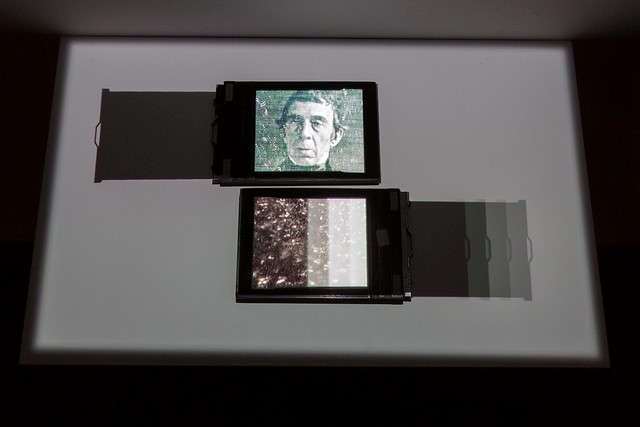
The series is inspired by daguerreotypes and investigates the life and death of technology, along with our emotional attachment to many of these technological devices that at the time were true miracles of engineering. The artist rescues them, as a tribute, and tries to show the more human side of technology. To this end, video animations are projected on their surface that seem to bring them back to the present.
DANIEL CANOGAR
Madrid, 1964
Lives and works in Madrid. She studied Image Sciences at the Complutense University of Madrid and obtained a Master's degree in Art with a specialization in Photography at New York University/International Center for Photography, New York. Since his beginnings he works combining photographs and light projections that make reference to the human body to analyze the behavior through visible fragments such as the face and hands or by exposing its internal construction based on images of cells, always using neutral media such as methacrylate, fiber optics or light projections.
Daniel Canogar's artistic projects and research deal with the relationship established between man and technology, reflecting on how it conditions our way of relating to the world and to our own body.
The artist has a direct and close relationship with Museo Universidad de Navarra and collaborates with the Master of Curatorial Studies by sharing with future curators the artist's vision and invites them to "put themselves in his shoes".
To learn more
Press site
Site masterclass of the artist April 20, 2019
Access the publication of the project
Access to the virtual tour of the exhibition
Available at the Museum's reception desk the Sikka Ingentium exhibition collectible and room sheet.
Disparates: Photography and Public Works could be enjoyed as an exhibition at Museo Universidad de Navarra between 25 OCT'17 and 1 APR'18. The collection of photographs Obras públicas formed by images of civil works in 19th century Spain belongs to Museo Universidad de Navarra (MUN) and serves as an excuse and inspiration to the artist for this project.
Juan Ugalde confronts these historical, old photographs in a very personal and contemporary way, mixing in each of them "local, nearby" elements: physical reality versus virtual reality.
Ugalde contrasts the old images, "the beginning of what has come later", with drawings that somehow anticipate what is to come, added elements that are not precisely "modern", but somehow also out of fashion, suggesting that there is not much promise about that future. The "Disparate" -which refers to Goya's Disparates-, Ugalde describes as "the one generated by progress (...) by the development of the human being in the last century and a half".
Juan Ugalde
Painter and photographer, in recent years he has been using the collage technique in his work. He has been working since the 80s, a time when he added comic elements to paintings of delirious realism and marginalization. His work can be found in museums such as the MNCA Reina Sofía in Madrid, the Patio Herreriano in Valladolid, La Caixa and ICO Foundations, and the Botín and Banco de España Collections, among others.
To learn more
Virtual tour of the exhibition
Available at the Museum's reception desk the collectible and the exhibition room sheet.

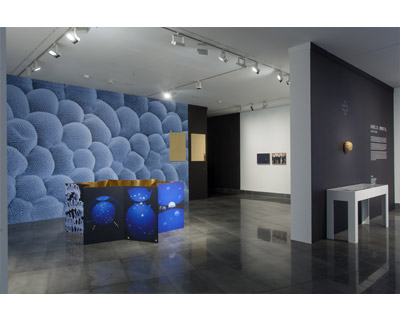
JAVIER VIVER
This project by Javier Viver focuses on the existence of a peculiar being: the aurelia aurita, a type of jellyfish that has the capacity for unlimited regeneration. Viver attempts to photographically document the life cycle of this species, guided by a scientific and metaphysical interest in a phenomenon found in nature that leads to a reflection on the possibility of immortality. The exhibition shows the photographic series generated by the artist, accompanied by a photobook designed by the author.
To learn more
Access to the exhibition website
Access to the virtual tour of the exhibition
Available at the Museum's reception desk the collectible and the exhibition room sheet.

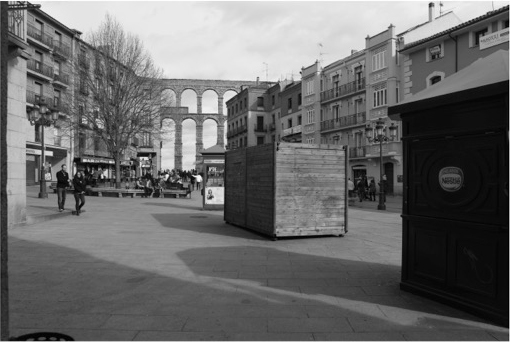
MANOLO LAGUILLO
The author's project consists of photographing several Spanish provincial capitals with very particular physical characteristics as a result of their recent histories. They do not belong to the rich periphery of the country, nor to the centre, and their role, with little growth over the last century, places them in the background. The transition with the countryside, an environment that these cities possess, is still quite similar to that of almost all cities in our country a hundred years ago, when industrialisation was practically non-existent. In these cities there is still no continuity between the dense urban core and the countryside, as the industrial estates and housing developments outside the city walls have not yet completely surrounded them. This physical characteristic is related to the size of these towns, which is sufficiently contained that, without having to fly, it is almost possible to cover them at a glance.
Laguillo's aim is that the photographs in this project continue to represent the maximum detail of reality, as he has always sought to do, and that this appears with the greatest possible tonal richness, because he wishes to achieve the most perfect degree of clarity and cleanliness, of illusion in short, that the photographic medium is capable of providing.
Las Provincias is on display for the first time in its entirety in the exhibition Projects: four decadesfrom 27 October 2021 to 23 March 2022. A full programme of activities was developed around the exhibition to understand the impact of this work and the issues it addresses.
The exhibition and the programme around it were supported by CORREOS DE ESPAÑA.
To learn more
Click here to access the virtual tour
Explanation by the artist about the exhibition Projects: four decades
Available at the Museum's reception desk the collectible and room sheet of the exhibition Projects: Four Decades.
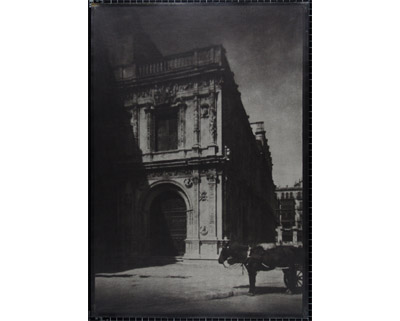
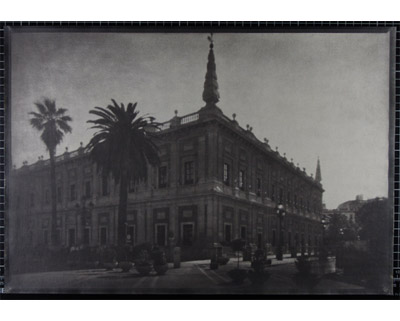
MANUEL BRAZUELO
His project for Tender Puentes is made with pinhole cameras and his positives are produced with the technique of bichromate rubber.
His decision to use this camera was due to the freedom it gave him to decide on the format of the negative. Moreover, the lines were always parallel to the axes of the negative, and the photographed scene was in focus in all its points.
The translation of the negatives to a pigment medium originated for Brazuelo in the exhibition Imágenes de la Arcadia (1984), curated by Joan Fontcuberta at the Biblioteca Nacional in Madrid. The impact he felt when he saw almost all the pigmentary processes and their different possibilities when it came to showing an image on paper, led him to adopt these methods. Brazuelo adopts the bichromate gum not as a result that he wants to show for its own sake, but for the iconic consequence that is produced after its conjunction with the pinhole. The project presented by the author is divided into two parts: Granada and Seville.
The images of Granada come from two years of careful observation of the Alhambra, until he decided to approach his work as if it were a fortress. He conceives his work with a series of routes that start from his own house to the walls that surround it in the mountain, without going beyond them, trying to show the essence of its interior.
His Seville series is based on plans of the city, where he marks the points where 19th-century travellers took photographs that for him have become icons of the city, executing his images in a way that incorporates looks that do not hide what the modern city had to offer.
To learn more
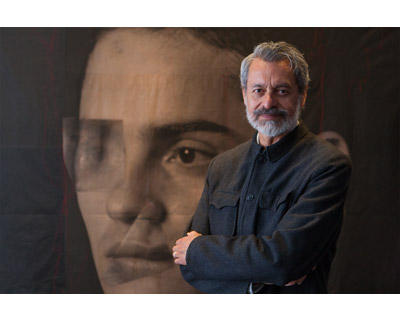
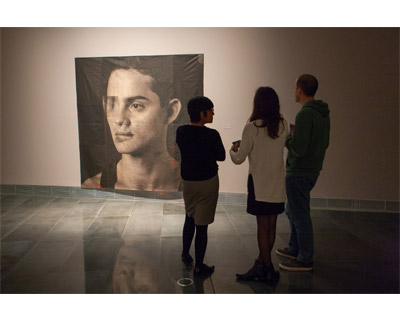
LUIS GONZÁLEZ PALMA
Through his work, González Palma experiments with the technical and formal solutions of photography, in a redefinition of the limits between photography and painting, influenced by his training as an architect and his approach to religious painting, which also generated an interest in abstraction.
In his work we can see a series of recurring motifs, including the importance of beauty, reflection on power and the concept of image and its perception by others. He reflects on the gaze, a reflection of how we see others and how we see ourselves, linked to the awareness of not being seen, and the uneasiness that this causes.
Throughout his work we see an evolution from concepts linked to identity and memory to the coexistence of abstraction and figuration, because for him both have the same purpose, to understand and give meaning to the image, again in relation to the gaze and the capture not only of the individual, but of the human condition. And this idea forms part of the importance of the portrait in his work, often in relation to formal solutions and to the spectator, who contemplates it without intermediaries.
To learn more:
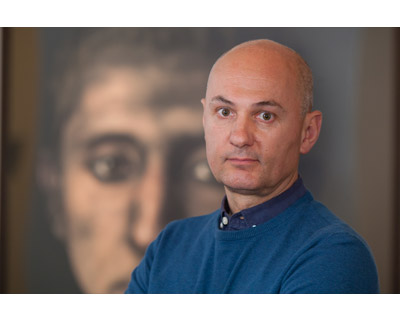
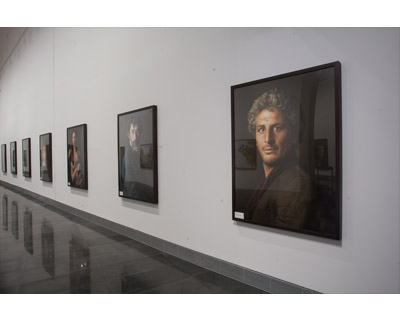
PIERRE GONNORD
The origin of the work De Laboris by Pierre Gonnord (Cholet, 1963) is to be found in the Museum's commission to participate with a project in the series Tender Puentes, based on the Museum's photographic collections. In the Museum's photographic collections, Gonnord discovered the portraits of past photographers, such as Napper or Laurent, but especially Tenison.
Gonnord's gaze focuses on characters disinherited by society, who are burdened by lineage and tradition. These anonymous faces arouse our emotions and become transcendent, timeless and eternal. Gonnord's work in De Laboris is based on the theme of portraiture, which he describes as mute interpellations that narrate unique stories in a sober way, through a simple language. The photographer takes these figures and gives them back their dignity, capturing them in close-up, full-length or bust-length, looking towards infinity, oblivious to the lens, the photographer or the public who contemplate them and who, by their presence, make them real and eternal.
His photographs reflect his empathy with the problems and life experiences of his subjects. To do so, Gonnord gets involved with these individuals and groups, living with them, getting to know them and grasping their essence, discarding what does not interest him and choosing those who will become the protagonists of his portraits, seeking to retain their charisma.
At The Gypsies of La Raya in which he portrays a racial group that, still living today, symbolise in the collective imagination a people that has been exiled for centuries, fighting for its survival and preservation in the face of globalisation. They are a nomadic group that lives halfway between Spain and Portugal, and they bring together the mixed heritage of the different races that populated the Iberian Peninsula with that of the gypsy people.
Whereas in The minersThe Miners, reflects a world already in decline, of heroes forged in the beginnings of the workers' and trade union movement. Gonnord portrays the miners of the Asturian-Leonese basin, in which, together with workers native to the region and heirs of long dynasties linked to the mine, there are now immigrants from different European mining basins, also heirs of an ancestral tradition, linked to a hard and difficult, but young and vital world of work, mostly made up of men.
To learn more
Access to the exhibition website
Access to the virtual tour of the exhibition
The artist's creative process
Mathaussen's suitcase
Available at the Museum's reception desk the collectible and the exhibition room sheet.
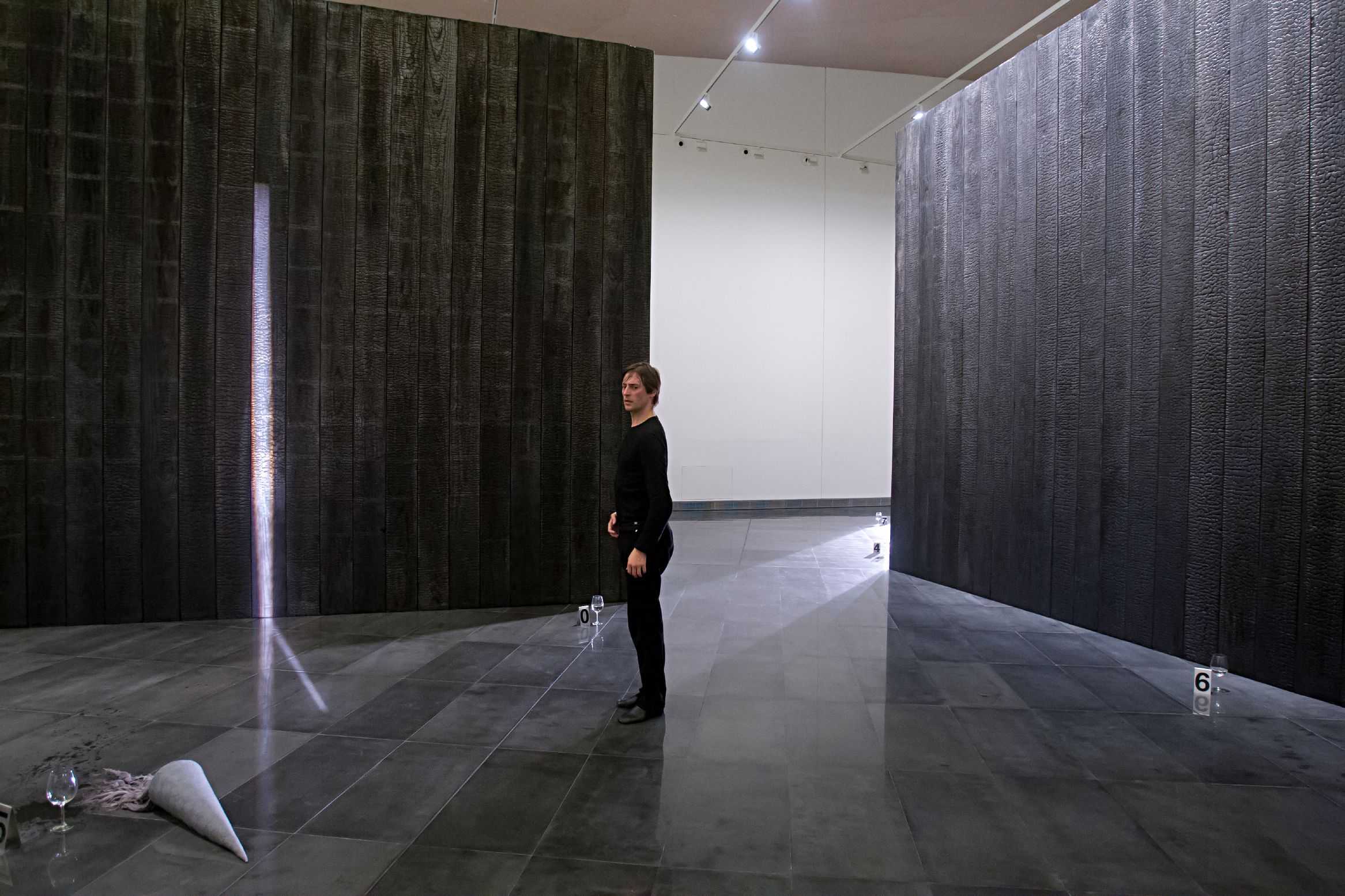
One of the inaugural exhibitions at Museo Universidad de Navarra and the first of the Tender Puentes projects that visitors were able to tour in the halls of Rafael Moneo's recently inaugurated building. It was also one of the first occasions in which the dance of Javier Martín and the work of a visual artist were put in dialogue through performances in the halls, one of the hallmarks of the Museum.
An impressive project carried out by Íñigo Manglano-Ovalle (Madrid, 1961) expressly designed for the La Caixa hall located on floor 0 of the MUN. The Madrid-born artist based in Chicago confronts current concerns from a poetic perspective in this work.
The project, with roots in German philosopher Martin Heidegger's essay Bauen, Denken, Wohnen (Building, Thinking, Living), took the form of two 5×5 meter cubes clad in charred radiata pine. The wood was charred using a Japanese architectural technique known as Shou Sugi-Ban, which is over a thousand years old. This procedure creates a charred, black and silver exterior that is naturally resistant to weather and decay.
The two cubes or huts were accompanied by large-scale images taken in the Quinto Real beech forest in northern Navarre, with the same texture as the charcoal itself. His printing process is also derived from charcoal, the central material of all his work.
The artist confronts us with issues such as deforestation, nature or the ecological impact of contemporary culture and poses an implicit critique of the relationship of human beings with nature through the image of coal.
The cubes are both sculpture and architectural intervention in space, and establish with the visitor a game of concealment, since at first glance the visitor will only perceive a large cube. It is necessary to walk through the room, to accept the invitation to the action and experience of space and place to reach a revelation that does not respond to the outer space, but leads to an inner illumination.
To learn more:
https://youtu.be/aSB34LdZmQw
Acquire the project book and exhibition catalog
Available at the Museum's reception desk the collectible and the exhibition room sheet.
LYNNE COHEN. SOUL MATES
The author has focused her project on various public and institutional buildings in the city of Pamplona and on the interiors of several spas in the region. Her gaze has always been attentive to interior spaces with functions related to waiting, transit and access. These are domestic places located inside public buildings, universities, hospitals or offices.
His way of observing reality maintains a certain parallelism with early 19th century photography in the treatment of the in-between and the attention paid to everything that is taken for granted or excluded from a certain official life because of its insignificance, although he has developed a poetics of objects closely linked to a description of situations in the absence of events. His gaze is far from an idea of remembrance or nostalgia for the passing of time, and emphasises the fragility of the present.
In the project in question, a certain monumentalisation of the circulation spaces is achieved through the compositional importance of the geometric in highly ordered situations in which certain ornamental elements structure the space.
To learn more
Access to the exhibition website
Available at the Museum's reception desk the collectible and the exhibition room sheet.
CARLOS CÁNOVAS. SEVENTH SKY
The author set out his project on the characterisation of a territory, choosing the town where he lives, Zizur Mayor, a few kilometres from Pamplona. His attitude is reminiscent of the first photographers who were attentive to capturing the most immediate reality around them.
Zizur Mayor is located on a hilltop overlooking nearby Pamplona, but is separated from it by a motorway that marks a border. The town is immersed in a vague peripheral sensation halfway between the city and the countryside, where empty plots of land awaiting urban development have replaced farming. The subject is not unfamiliar to Carlos Cánovas, who has been dealing with this type of suburban landscape since the 1980s, but on this occasion he undertakes a systematic documentation to describe and establish the character of a single place, as in a case study.
The territory of Zizur, although it is not strictly speaking a periphery, nor has it developed as such, assumes these conditions as a balanced paradox. In a certain way Carlos Cánovas seems to reformulate these questions by summarising them in the idea of a flexible territory, where the non-place ceases to be a transit or provisional space and becomes a stable and dynamic structure at the same time.
To learn more
Access to the virtual tour of the exhibition In Timeby Carlos Cánovas
Available at the Museum's reception desk the collectible and room sheet of the exhibition In Time


SERGIO BELINCHÓN. 'SUN PICTURES IN SPAIN'.
The author has constructed the image of the Spanish tourist territory, based on two albums from the workshop of Henry Fox Talbot, Annals of the Artists of Spain, and Sun Pictures of Scotland, in which the route tends to emphasise an elegiac vision of Scottish nature and from which the artist borrows the title of his project: Sun Pictures of Spain. The journey along the Levantine and Canary Islands coast reveals a continuous space of housing estates and motley buildings that distance us from the landscape and immerse us in a territory of standardised non-places.
The dialogue with the 19th century is not only thematic, it is also one of use and meaning. While the beach was a space for boats and fishermen, photography linked to the picturesque was possible. When that same space has been filled with deckchairs and parasols, all that remains is domestic photography, the last extreme of the democratisation of the gaze and of memory. While painting was the medium of the image, only the economically powerful classes could enjoy history and memory. The development and popularisation of photography established an endless multiplication of narratives, but also a trivialisation of discourses.
By focusing on tourism, Sergio Belinchón approaches a territory constructed from a gaze that passes through the compact cameras of the tourist with its clichés and its postcards in the digital memory.
To learn more:
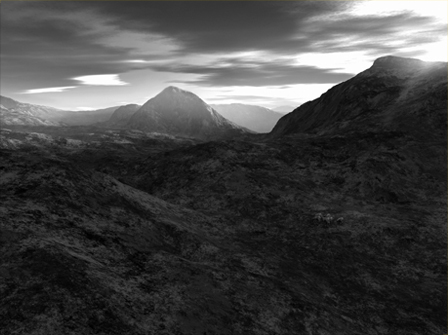
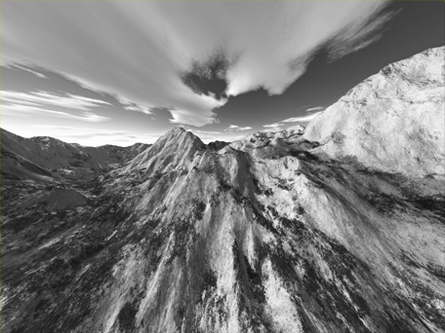
JOAN FONTCUBERTA. OROGENESIS: GIBRALTAR'.
The author worked from an album of Gibraltar where there were photographs commissioned by a military commission of different positions of the orography and port of the Rock. These images were converted by Fontcuberta into mathematical data that made it possible to generate a landscape using the Terragen programme, in which a series of modifications were introduced.
It is a technical transfer in which a chemically processed image is transformed into a new digital image. The new landscapes that make up the Orogenesis series show an aspect that apparently, from their whimsical forms, has more to do with the creations of the landscape gardeners described by Poe than with the landscape photographers in the style of Anselm Adams, in search of the national image of a promised land. However, the aims are quite different. It is not a question of creating the image of a dreamed-of space, but of putting into crisis the patterns of description of reality and its photographic presuppositions. Fontcuberta's work involves both the crisis of the photographic technique and the crisis of the archive, and also affects the way in which the refinement of these computer programmes threaten the iconic status of photography as a literal transcription of reality.
To learn more
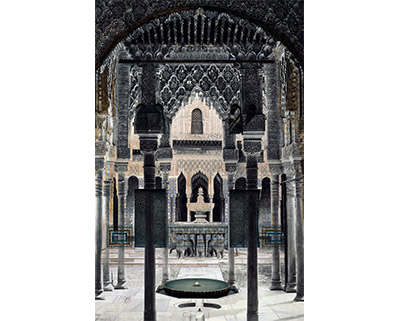
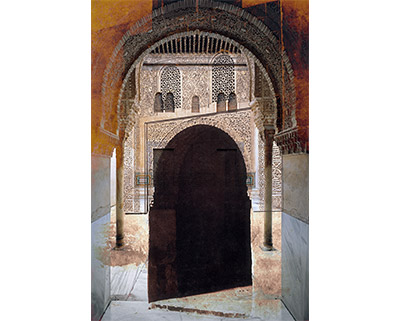
ROLAND FISCHER. REFLECTIONS IN THE SHADOW
The author had worked in Spain on a project on the cathedrals of the Camino de Santiago. For this project he chose various 19th-century images from Toledo, Salamanca, Valladolid and above all Granada as a bridge for dialogue, focusing on the Alhambra and later on the Reales Alcázares in Seville. Nor is Fischer driven to a description of the monument. On the contrary, he undertakes a visual reinterpretation that gives an account, from a more imaginative perspective, both of the character of Arab architecture, highlighting its elements and ornamental combinations, and of its visual impact and the importance of the memory of the photographic tradition in today's gaze.
The resulting vision is polyhedral and allows access to a combinatory and relational reading. In the images of the Alhambra, the superimposed volumes organise a diversity of planes that highlight a new and disturbing depth. His gaze takes the ornamental accumulation to excess in order to emphasise the density that lies in its lightness. He combines and inserts, as if he were an architectural gardener, constructive elements, creating new effects of form and colour: paradoxical visual effects that express the versatility of architecture itself and visually reflect the inner workings of the building. To accentuate the idea of depth in the play of planimetry and volume that constantly emerges in the building, Fischer uses some images from the 19th century that he subtly integrates into his image, establishing a direct dialogue with the 19th century, both as a memory and as his own visual tradition.
To learn more
JAVIER VALLHONRAT. "42º N"
Javier Vallhonrat 's encounter with the pioneering photographs taken in 1853 by the French Viscount Joseph Vigier during his journey in the Pyrenees coincides in time with the series of projects that the Spanish artist is developing around the experience of the high mountains or environments with particular geoclimatology.
In particular, the two photographs that Vigier took of the Aneto and Maladetas glaciers, which are part of the Collection of Museo Universidad de Navarra, will be the starting point of the 42ºN project, developed over 15 months in the Maladeta Massif, in the Aragonese Pyrenees.
The definition of the strategic axes of the project is nourished by elements that the artist has found through his research into the work of Joseph Vigier: the accumulation of fragmentsof experience over numerous itineraries in a high mountain environment, the use of geographical and cartographic data and their insertion in paradoxical contexts and the establishment of a space of representation that lies between the topographical description of the documentary model and a photographic approach that is both abstract and narrative.
42ºN has meant for the artist to look, literally and metaphorically, towards the place where Vigier directed his gaze in 1853 and to explore that place, simultaneously geographical, phenomenal and of the constitution of language.
The photographs and videographic pieces that make up the 42ºN project involve for the artist the creation of a space for investigating internal phenomena based on representations of an external territory.
Using a methodology of accumulation of data (fragments) of experience as well as quantitative data (geographical, chronometric and cartographic) resulting fromobservations maintained over time, and their insertion in a paradoxical contextual framework, the artist investigates not so much the phenomena on which his gaze stops, but the language resulting from these interventions.
To learn more
How Interactions was made, by Javier Vallhonrat
Go to the Interactions exhibition site
Purchase at the Museum's reception desk the collectible and exhibition room sheet.
JORGE RIBALTA. 'SCRAMBLING'.
Jorge Ribalta considers the Alhambra as a post-industrial factory, in four senses:
- The Alhambra as a monument, a built place.
- The Alhambra as a treasure, because of the heritage and history it reflects.
- The Alhambra as a city, because it has a life of its own, generated by its employees and also by its visitors, who come to its public space.
- And, finally, as an economy, because of its vision as a monument that brings wealth.
One of the most relevant aspects of the work is the moment at which it was made, as the photographs were taken at a time when the Patio de los Leones is closed to the public. The paradoxical nature of the situation also reflects the artist's intention to show the monument at a time when it is not visible, as well as in a new form.
According to Ribalta, his work is based on two pillars:"on the photography collection that the Museo Universidad de Navarra has, which is a very important collection for the reconstruction of national history; and, specifically, on two photographs by Charles Clifford such as the Puerta del Vino or Templete", both from the late nineteenth century with the Alhambra as a theme, and which belong to that collection.
The 77 pieces that make up "Scrambling" are grouped into 10 series that reflect key aspects of both the creative process of his work and the message and the way in which the monument is transmitted:
- The inspiration: an image of Chrales Clifford's The Wine Tower, shown from an open book, combined with photographs reflecting a researcher's dream of viewing the archive.
- The urban, public part of the monument. The rest area.
- Security. The Guardia Civil helicopter flying over the monument reflects the security arrangements for a political visit. The monument's defence tower.
- Its employees. Understand how the monument is produced by the work of different people. Guided tour, restoration architect... Portraits of the people who make it possible.
- Gardening.
- Water. Water route and reservoir. Below the public part of the monument.
- Stone, another key element. Series of plasterwork.
- The Gorge of the lions. The restored lion.
- The Public. Ticket sales, half-time, buses, security...
- Commercial exploitation of the monument: shop, postcards, printing on demand...
The Scrambling series could be seen in its entirety in the exhibition Everything is true. Fictions and documents (1987-2020), which occupied the rooms on floor -1 of the Museum from October 19, 2022 to March 12, 2023.
To learn more
Access here to the virtual tour of Everything is true, Fictions and documents including Scrambling
Available at the Museum's reception desk the collectible and room sheet of the exhibition All is truth, Fictions and documents.
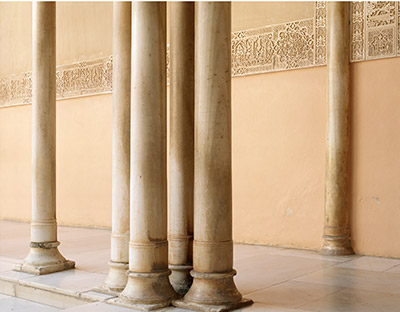
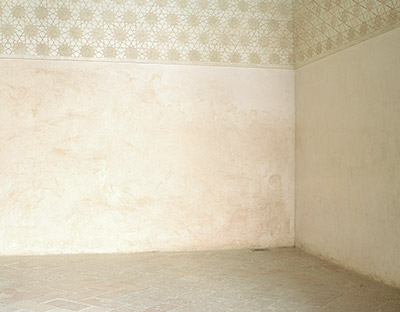
BLEDA AND ROSA. THE ALHAMBRA
The authors undertook their project on the Alhambra by creating a path for the deconstruction of a monument, based on a route of intermediate and transit spaces that could refer to a vision of familiarity and everyday naturalness. The project proposes the creation of two complementary routes, one that penetrates the interior and observes the guts of the monument, and another around the perimeter that allows us to observe the landscape and access the views of the surroundings.
It was the first time that the photographers had visited Granada, but their first glance was already influenced by a photographic iconographic tradition that had already, since the 19th century, produced a meticulous description of the monument. Placing themselves in the role of the travelling photographer, they contemplated the site thinking of their predecessors and the images they had bequeathed to them. Bleda y Rosa hardly stop at the courtyards; they focus on the spaces that connect the halls and gardens, on the worn walls of the intermediate rooms. It is these non-monumental spaces that attract their attention because they reveal in a more natural way the residential character and use of the palace. When the photographers were looking for possible locations for the landscape shots, they realised that the trees had grown out of all proportion and their canopies obscured the view of Granada. Like a wall of vegetation, the trees stood in the way like a veil, revealing only chinks and fragments of buildings. The landscape thus excludes panoramic views and allows the images that were taken in the 19th century to emerge in the memory.
To learn more:
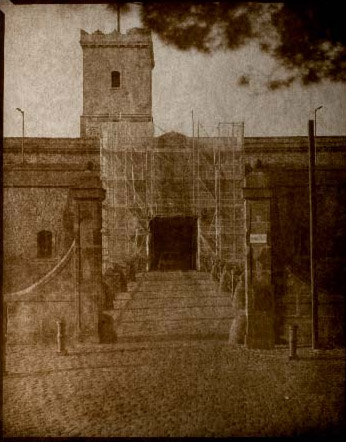
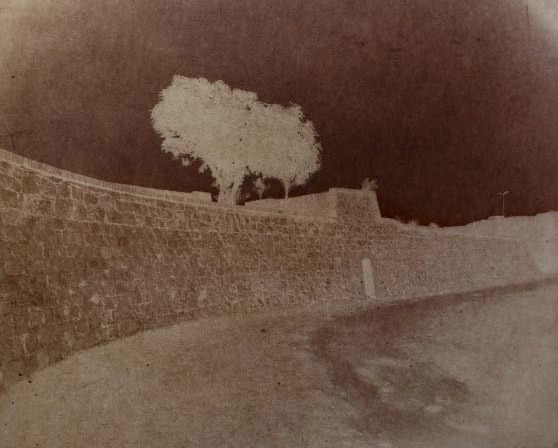
MARTÍ LLORENS. 'STRATOS'.
This project takes as its object the Montjuïc fortress in Barcelona, a place that has formed part of the history, memory and imaginary of the city since the mid-17th century.
This project aims to look at, think about and represent this place as a strange space out of time and out of context, questioning it as a lost object that is definitively alien and strange to its initial value of use. In the wake of this lost object, the photographs have been taken using a 19th century procedure devised for architectural and landscape photography, the waxed paper negative. The final piece is no longer a positive image but the negative itself, thus becoming an object alien to its initial use value and, of course, completely foreign in the world of digital imaging. The elaboration and processing of these negatives, the weight and volume of the equipment used, the long exposure and development times, in short, the rhythm and type of work required, are also completely alien to what we have long conceived of as photography. These and other contingencies are what give these photographs an essential and sought-after antagonistic time, a precious element in this project.
For Llorens, his taste for working with history, traces and memory leads him to work on the concept of artistic creation understood as a means of recovering objects, a recovery that leads to new and unexpected uses.
XAVIER RIBAS. 'GEOGRAFÍAS CONCRETAS (CEUTA Y MELILLA)'.
The project realized by Xavier Ribas for Tender Puentes addresses the representation of the contemporary European landscape from two photographic tours along the border fences of Ceuta and Melilla. Concrete Geographies (Ceuta and Melilla) are two photographic grids of 22 and 26 photographs each, in which the author visualizes the landscape defined by these fences that delimit at the same time a colonial/national border between Spain and Morocco, an economic border between Europe and Africa, a geopolitical border between North and South and a religious border between Christianity and Islam.
As Xavier Ribas himself explains, "the border fences of Ceuta and Melilla are to the European landscape of the 21st century what the bridges, tunnels and railways were to the landscape of the second half of the 19th and early 20th centuries".
In the photographic albums of public works by authors such as Clifford, Laurent and Minier and José Manuel Sánchez, from the collection of the University of Navarra, bridges, roads, tunnels and railways form a new landscape marked by the desire to open up the territory, to move, circulate, exchange and communicate. The border fences of Ceuta and Melilla also define a new landscape, but this time it is a landscape of secession, an architecture of exclusion, born of poverty and openly racial.
In the words of Xavier Ribas, these photographs are intended as"statements towards a political cartography of the border fences of Ceuta and Melilla as the true confines of Europe. The fences of Ceuta and Melilla are the contemporary public works that can best define, as monuments to inequality, the European landscape of the 21st century".
To learn more
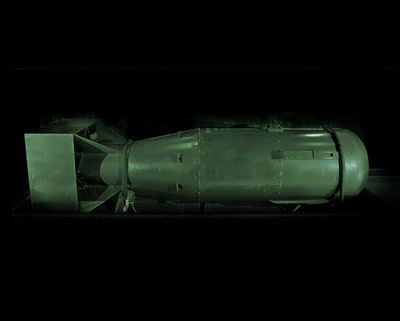
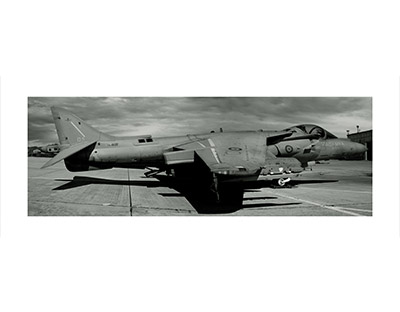
VALENTÍN VALLHONRAT. ORNAMENTAL PHOTOGRAPHY
His work is initially focused on the revision of the concept of the album as a possible prototype of the archive, to later discuss the notion of authorship and the dialogue with a tradition of photographic documentation.
His project has been extended over time and has run parallel to the development of Tender Puentes, of which he is one of the promoters, specifying and narrowing its theoretical framework. The starting point of the project are the albums that document the Royal Armory of Madrid, which were made in the 1860s. Valentín Vallhonrat starts from the visual reinterpretation of helmets, shields and armor present in the Madrid Armory and in the Imperial Armory of Vienna, which are treated from the interrelation with the descriptive model applied by Clifford and Laurent. Simultaneously, his interest is directed towards contemporary weaponry, helicopters, airplanes, submarines and projectiles, as technological equivalents of armor and as machines endowed with beauty that summarize the character of contemporary models of efficiency (in this case efficiency of destruction).
Images of contemporary weaponry alternate with documentation in almost solarised colours of historical armour and gauntlets, some of which are enclosed in their display cases, highlighting the continuity of an archive.
To learn more:
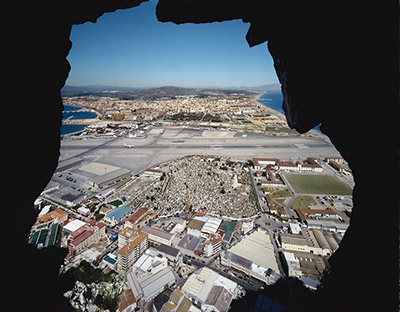
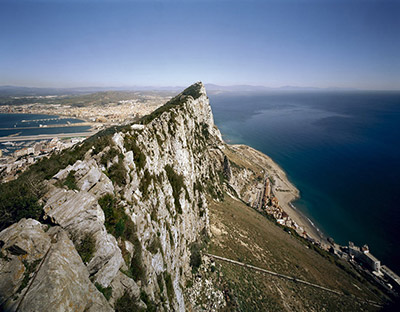
JORDI BERNARDÓ. GIBRALTAR
This author's training in areas close to urban planning and architecture have enabled him to understand how contemporary territory is articulated from a configuration of non-places, which end up being spaces of cultural significance despite their emptiness.
The term non-place was coined by Marc Augé and has been used to describe the articulation of contemporary space and territory through anonymous and standardised places of transit. Jordi Bernadó tours Gibraltar with a gaze that is more analytical than descriptive, highlighting the peculiarities of a theme park that has the scale of a territory. Tourism and entertainment are intertwined with a military base, whose history is exhibited in an informative version, with wax figures staging anecdotes and historical events.
Tourism does not entirely define the territory of the Rock, but it offers content and meaning to its strangely decorated landscape. The connection of the photographs in the project with the images in the 19th century albums is very direct and tends to show the changes that have taken place in the way places are understood. While the album emphasises the topographical, the project is dominated by the strangeness to which the present-day non-places refer and which tends to short-circuit the critical gaze.
To learn more
GABRIELE BASILICO
The author takes a look at the industrial urban landscape in a journey that includes the municipalities of Pasaia and Lezo, and goes as far as San Sebastian.
Gabriele Basilico, after graduating as an architect in 1973, has devoted himself extensively to the documentation of cities and their urban and industrial landscapes. His project for Tender Puentes , realized through black and white panoramas, takes us back to his first important project realized between 1978 and 1980 on the industrial outskirts of Milan.
In his work carried out in the north of Spain, the author revisits his concern with the exploration of contemporary cities and landscapes, generated in the transition from the industrial to the post-industrial era, with the profound architectural and urbanistic alterations that this transformation has brought about, especially for the industrial peripheries of many European cities. The images presented combine the harsh industrial image with the poetics of the environments recovered for iconographic memory.

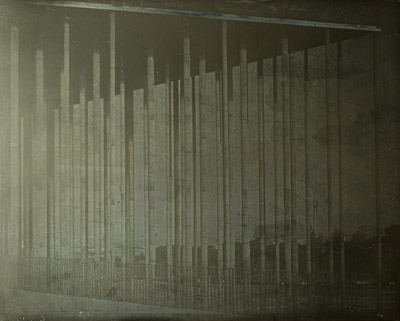
ANGEL FUENTES
The author carried out his project as a tribute to his own discovery of photography. He prepares his material by scrupulously following Daguerre's first manual, which appeared in Paris a month after the French government decided to free the process from any kind of patent. Following the instructions in this manual, the silver surface is sensitised with iodine vapour until it turns an intense yellow. The sensitivity of the plate is very small, so outdoor shots will take a similar time to those used 170 years ago, i.e. between 20 and 30 minutes depending on the weather conditions.
Prolonged exposure produces, in the high-light area, an effect similar to solarisation. We can see this clearly in the earliest examples of the shots that Daguerre took from his studio.
Ángel Fuentes takes a series of three shots from his studio, in which the iconic contents are subordinated to the problem of solarisation itself. He chooses three different days, at exactly the same time of day, and in three different directions to point the camera at, looking for three different lighting conditions: compensated light and shadow, very strong light and very pronounced shadow. The next series is shot at street level. He confronts the buildings and the environment left after the Zaragoza International Exposition.
The result documents the difficulties encountered by the early daguerreotypists: flat-looking images combined with the mystery and beauty produced by opaque-looking metallic objects.
